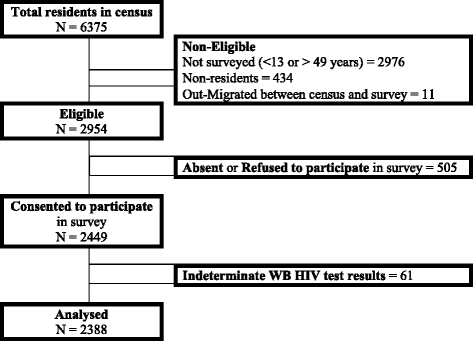"The Cango Lyec Project - Healing the Elephant": HIV related vulnerabilities of post-conflict affected populations aged 13-49 years living in three Mid-Northern Uganda districts
- PMID: 27871229
- PMCID: PMC5117608
- DOI: 10.1186/s12879-016-2030-0
"The Cango Lyec Project - Healing the Elephant": HIV related vulnerabilities of post-conflict affected populations aged 13-49 years living in three Mid-Northern Uganda districts
Abstract
Background: The protracted war between the Government of Uganda and the Lord's Resistance Army in Northern Uganda (1996-2006) resulted in widespread atrocities, destruction of health infrastructure and services, weakening the social and economic fabric of the affected populations, internal displacement and death. Despite grave concerns that increased spread of HIV/AIDS may be devastating to post conflict Northern Uganda, empirical epidemiological data describing the legacy of the war on HIV infection are scarce.
Methods: The 'Cango Lyec' Project is an open cohort study involving conflict-affected populations living in three districts of Gulu, Nwoya and Amuru in mid-northern Uganda. Between November 2011 and July 2012, 8 study communities randomly selected out of 32, were mapped and house-to-house census conducted to enumerate the entire community population. Consenting participants aged 13-49 years were enrolled and interviewer-administered data were collected on trauma, depression and socio-demographic-behavioural characteristics, in the local Luo language. Venous blood was taken for HIV and syphilis serology. Multivariable logistic regression was used to determine factors associated with HIV prevalence at baseline.
Results: A total of 2954 participants were eligible, of whom 2449 were enrolled. Among 2388 participants with known HIV status, HIV prevalence was 12.2% (95%CI: 10.8-13.8), higher in females (14.6%) than males (8.5%, p < 0.001), higher in Gulu (15.2%) than Nwoya (11.6%, p < 0.001) and Amuru (7.5%, p = 0.006) districts. In this post-conflict period, HIV infection was significantly associated with war trauma experiences (Adj. OR = 2.50; 95%CI: 1.31-4.79), the psychiatric problems of PTSD (Adj. OR = 1.44; 95%CI: 1.06-1.96), Major Depressive Disorder (Adj. OR = 1.89; 95%CI: 1.28-2.80) and suicidal ideation (Adj. OR = 1.87; 95%CI: 1.34-2.61). Other HIV related vulnerabilities included older age, being married, separated, divorced or widowed, residing in an urban district, ulcerative sexually transmitted infections, and staying in a female headed household. There was no evidence in this study to suggest that people with a history of abduction were more likely to be HIV positive.
Conclusions: HIV prevalence in this post conflict-affected population is high and is significantly associated with age, trauma, depression, history of ulcerative STIs, and residing in more urban districts. Evidence-based HIV/STI prevention programs and culturally safe, gender and trauma-informed are urgently needed.
Keywords: HIV; Northern Uganda; Post conflict; Prevalence; Risk factors.
Figures

Similar articles
-
Cango Lyec (Healing the Elephant): HIV Prevalence and Vulnerabilities Among Adolescent Girls and Young Women in Postconflict Northern Uganda.J Acquir Immune Defic Syndr. 2023 Oct 1;94(2):95-106. doi: 10.1097/QAI.0000000000003234. Epub 2023 Sep 11. J Acquir Immune Defic Syndr. 2023. PMID: 37276188 Free PMC article.
-
Cango Lyec (Healing the Elephant): HIV incidence in post-conflict Northern Uganda.EClinicalMedicine. 2020 Jun 18;23:100408. doi: 10.1016/j.eclinm.2020.100408. eCollection 2020 Jun. EClinicalMedicine. 2020. PMID: 32577610 Free PMC article.
-
Cango Lyec (Healing the Elephant): Chronic Hepatitis B Virus among post-conflict affected populations living in mid-Northern Uganda.PLoS One. 2021 May 27;16(5):e0251573. doi: 10.1371/journal.pone.0251573. eCollection 2021. PLoS One. 2021. PMID: 34043637 Free PMC article.
-
Cango Lyec (Healing the Elephant): Probable post-traumatic stress disorder (PTSD) and depression in Northern Uganda five years after a violent conflict.J Migr Health. 2022 Jun 19;6:100125. doi: 10.1016/j.jmh.2022.100125. eCollection 2022. J Migr Health. 2022. PMID: 35832466 Free PMC article.
-
Cango Lyec (Healing the Elephant): Gender Differences in HIV Infection in Post-conflict Northern Uganda.J Acquir Immune Defic Syndr. 2018 Jul 1;78(3):257-268. doi: 10.1097/QAI.0000000000001671. J Acquir Immune Defic Syndr. 2018. PMID: 29509587 Free PMC article.
Cited by
-
Cango Lyec (Healing the Elephant): HIV Prevalence and Vulnerabilities Among Adolescent Girls and Young Women in Postconflict Northern Uganda.J Acquir Immune Defic Syndr. 2023 Oct 1;94(2):95-106. doi: 10.1097/QAI.0000000000003234. Epub 2023 Sep 11. J Acquir Immune Defic Syndr. 2023. PMID: 37276188 Free PMC article.
-
Cango Lyec (Healing the Elephant): HIV incidence in post-conflict Northern Uganda.EClinicalMedicine. 2020 Jun 18;23:100408. doi: 10.1016/j.eclinm.2020.100408. eCollection 2020 Jun. EClinicalMedicine. 2020. PMID: 32577610 Free PMC article.
-
A scoping review of the associations between mental health and factors related to HIV acquisition and disease progression in conflict-affected populations.Confl Health. 2018 Jun 1;12:20. doi: 10.1186/s13031-018-0156-y. eCollection 2018. Confl Health. 2018. PMID: 29881448 Free PMC article.
-
Cango Lyec (Healing the Elephant): Chronic Hepatitis B Virus among post-conflict affected populations living in mid-Northern Uganda.PLoS One. 2021 May 27;16(5):e0251573. doi: 10.1371/journal.pone.0251573. eCollection 2021. PLoS One. 2021. PMID: 34043637 Free PMC article.
-
Prevalence of depression in Uganda: A systematic review and meta-analysis.PLoS One. 2022 Oct 20;17(10):e0276552. doi: 10.1371/journal.pone.0276552. eCollection 2022. PLoS One. 2022. PMID: 36264962 Free PMC article.
References
-
- Republic of Uganda Ministry of Health, World Health Organization: Health and mortality survey among internally displaced persons in Gulu, Kitgum and Pader districts, northern Uganda. In.: World Health Organization; 2005.
-
- Organization WH. Health action in crises: Uganda. In.; 2007.
-
- Fabiani M, Yoti Z, Nattabi B, Ayella EO, Opio AA, Musinguzi J, Garcia Calleja JM, Declich S. Adjusting HIV prevalence data from a program for the prevention of mother-to-child transmission for surveillance purposes in Uganda. J Acquir Immune Defic Syndr. 2007;46(3):328–331. doi: 10.1097/QAI.0b013e31815724e7. - DOI - PubMed
-
- Fabiani M, Nattabi B, Opio AA, Musinguzi J, Biryahwaho B, Ayella EO, Ogwang M, Declich S. A high prevalence of HIV-1 infection among pregnant women living in a rural district of north Uganda severely affected by civil strife. Trans R Soc Trop Med Hyg. 2006;100(6):586–593. doi: 10.1016/j.trstmh.2005.09.002. - DOI - PubMed
MeSH terms
Grants and funding
LinkOut - more resources
Full Text Sources
Other Literature Sources
Medical

